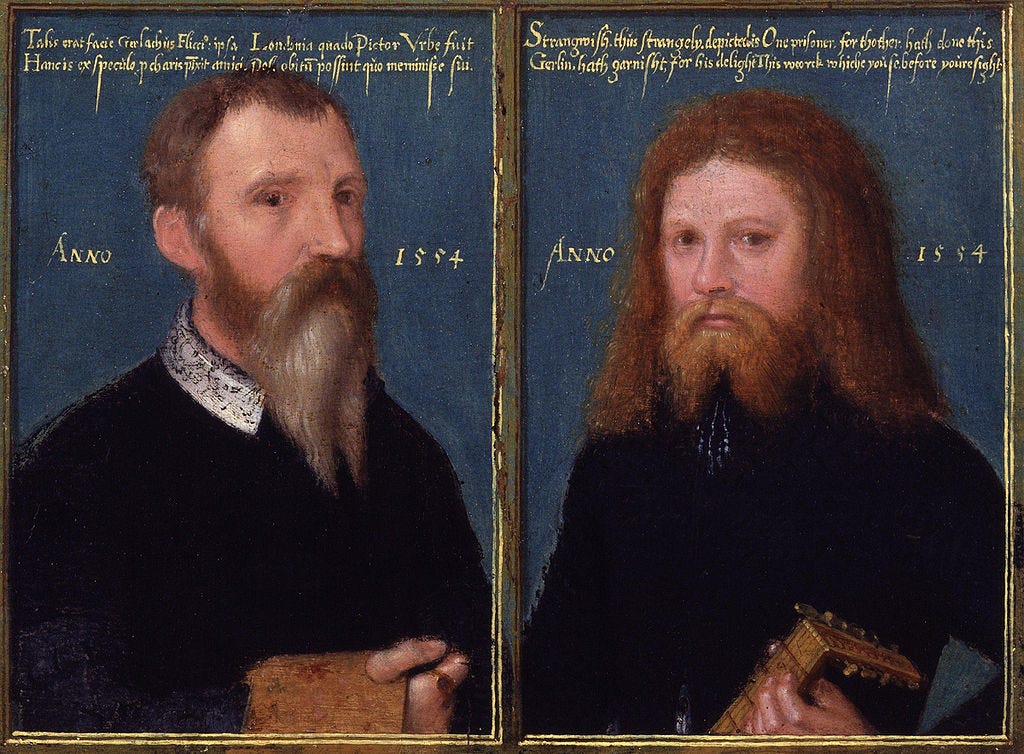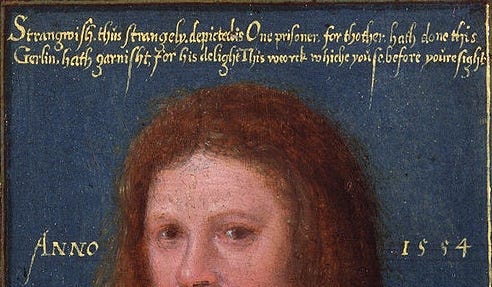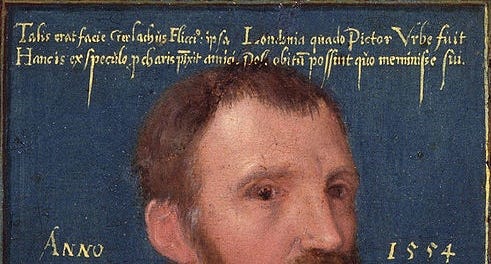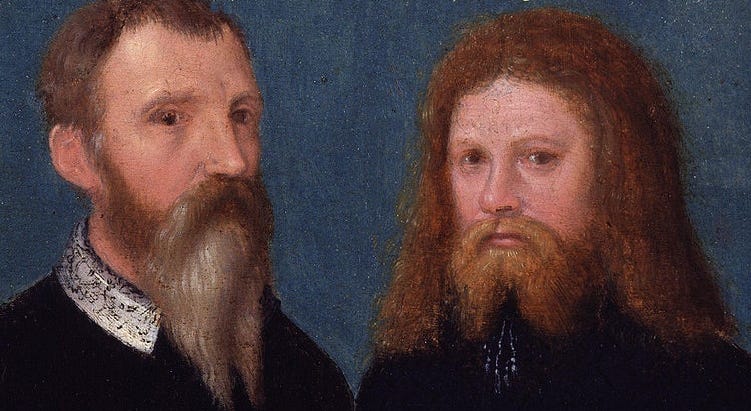Two Gentlemen of London
Remember me, remember me...
As I've mentioned before, my favourite art gallery in the world is the National Portrait Gallery in London. I like it because it's full of faces. Sure, I love strolling around any art gallery, and will take an interest in any Marcel Duchamp bicycle wheel, Goya lithograph, Turner seascape, or Hockney swimming pool, but it is to the gallery of faces I've returned most often. Faces are "characters," and I'm in the business of creating characters; albeit on paper, and in words, as I can't draw to save myself.
The double portrait below (a diptych painted on vellum) caught my eye the first time I visited the NPG. It's a Tudor-era work; the costuming and the date of 1554 (it's inscribed on it) are the big giveaway. But the most immediate thing about the work is its size; it's only 100 mm tall (4 inches). It's one of the smallest oil paintings in the gallery (depending on your monitor/phone screen configuration, you may even be viewing it larger than it really is).
It's an odd painting; very simple, very small, and somewhat engaging. This is not a double portrait of two kings, two dukes, or even two wealthy merchants; the plainness of their attire, and the minimalism of the work speaks to that. But there is a discernible sense of dignity about these two gentlemen.
The man on the left holds an artist's palette; the man on the right, a lute. This says:
This is how we wish to be known: Art and Music.
Above each of the men, finely inscribed, are lines of text. Above the artist are two lines of Latin. Above the musician are two lines of English. Unless you are fluent in Latin, you immediately head to the English…
Strangwish, thus strangely depicted is One prisoner, for thother, hath done this Gerlin, hath garnisht, for his delight This woorck whiche you se, before youre sight.
The key takeaways in this humorous, punning slice of ye olde English are the words "prisoner" and "garnisht." The latter is Tudor-era slang for "giving something to your prison warden to obtain the conveniences of life." So, to paraphrase the inscription: The man with the lute is Strangwish (Henry Strangways). He is a prisoner, and this "which you see before you" was done to buy a little comfort for his life.
The Latin inscription is of a different mood.
Such was the face of Gerlach Flicke when he was a painter in the City of London. This he himself painted from a looking-glass for his dear friends. That they might have something by which to remember him after his death.
Sombre, huh?
The man with the artist's palette is Gerlach Flicke, a German portrait painter known for his work in the Tudor court at London. It's a self-portrait, and to paraphrase his inscription: He thought he was going to die.
Flicke and Strangways were prisoners in the Tower of London. Friends and companions, or simply comrades in captivity? We will probably never know. Strangways was a "gentleman" pirate (it was a narrow channel between pirate and privateer). History never recorded why Flicke was jailed. Maybe the Queen (Mary (Bloody)) didn't like something he said when he painted her portrait?
Could Strangways play the lute? History didn't record that either, but as a pirate, he probably enjoyed a bit of wine, women, and song. But history did record that he wanted to steal an island from Philip II of Spain; yes, an island. I like this man.
Flicke is noted, but never became notable as an artist. He is, sadly, more of a footnote. This painting is his most famous piece. It's good, but really, it's well known more because it's recognized as the first ever self-portrait painted in oils in England.
And knowing the conditions it was painted explains its starkness. I've never visited the Tower of London, and I doubt I ever will. I know way too much about the abject horrors that took place within its walls, and there are frankly better things to visit when in London.
This is how we wish to be remembered: This is all we have left.
I am reminded of Henry Purcell's When I am laid in earth, and its haunting lyric:
Remember me, remember me, but ah! forget my fate.
Neither man died in the Tower; Strangwish was pardoned by Queen Elizabeth I. Gerlach Flicke 1495-1558 Henry Strangwish (Strangways) ?-1562
First published: Sleuthsayers.org (November 23, 2018)
©2018 Stephen Ross





